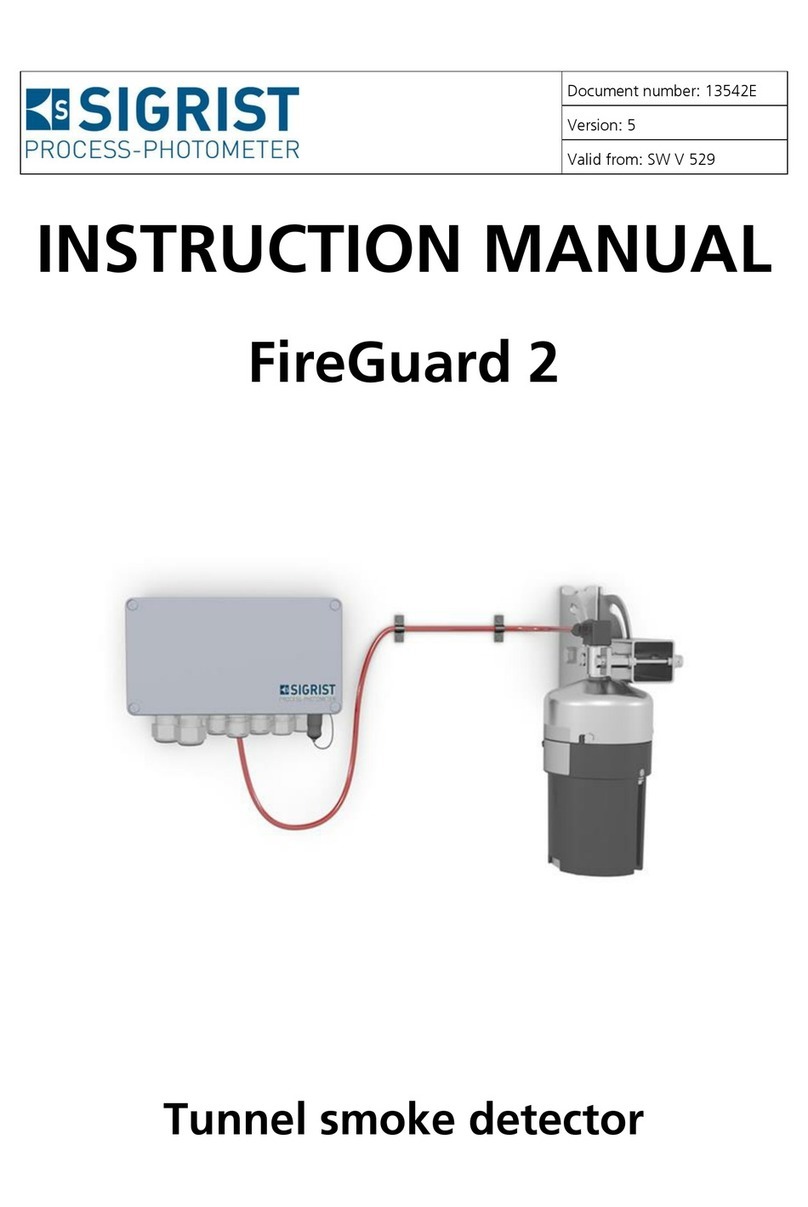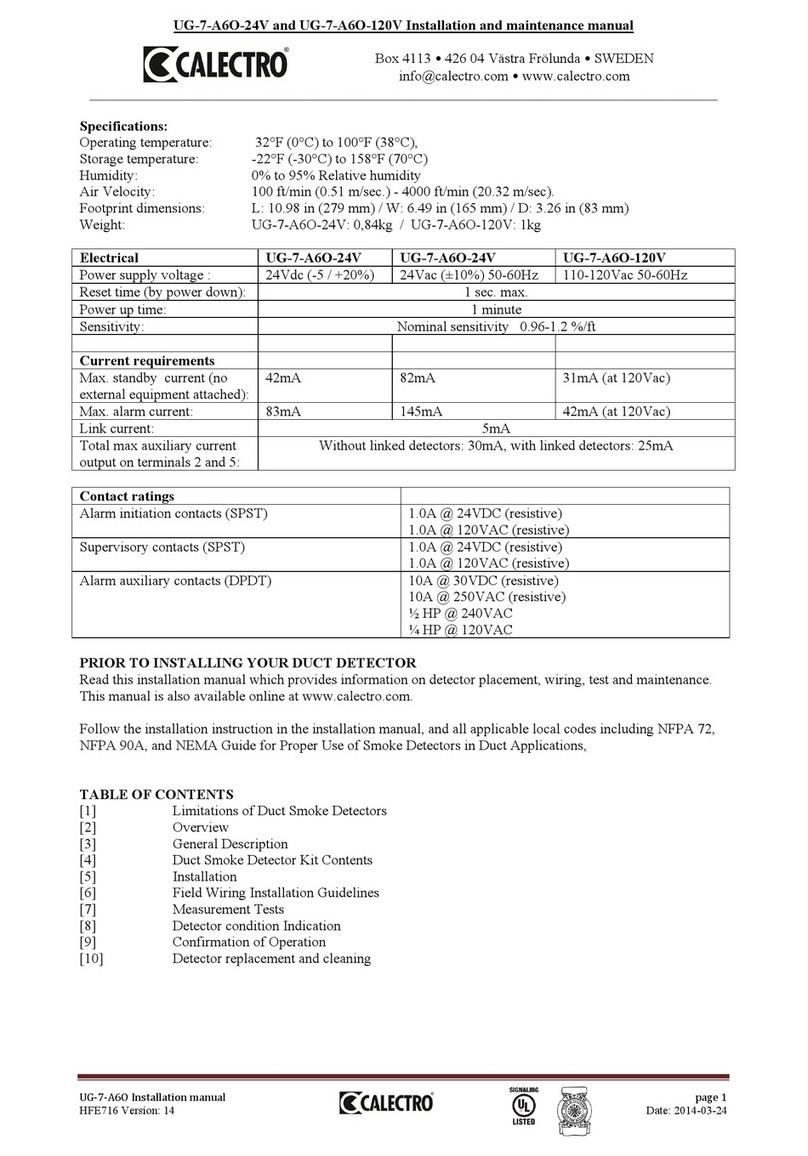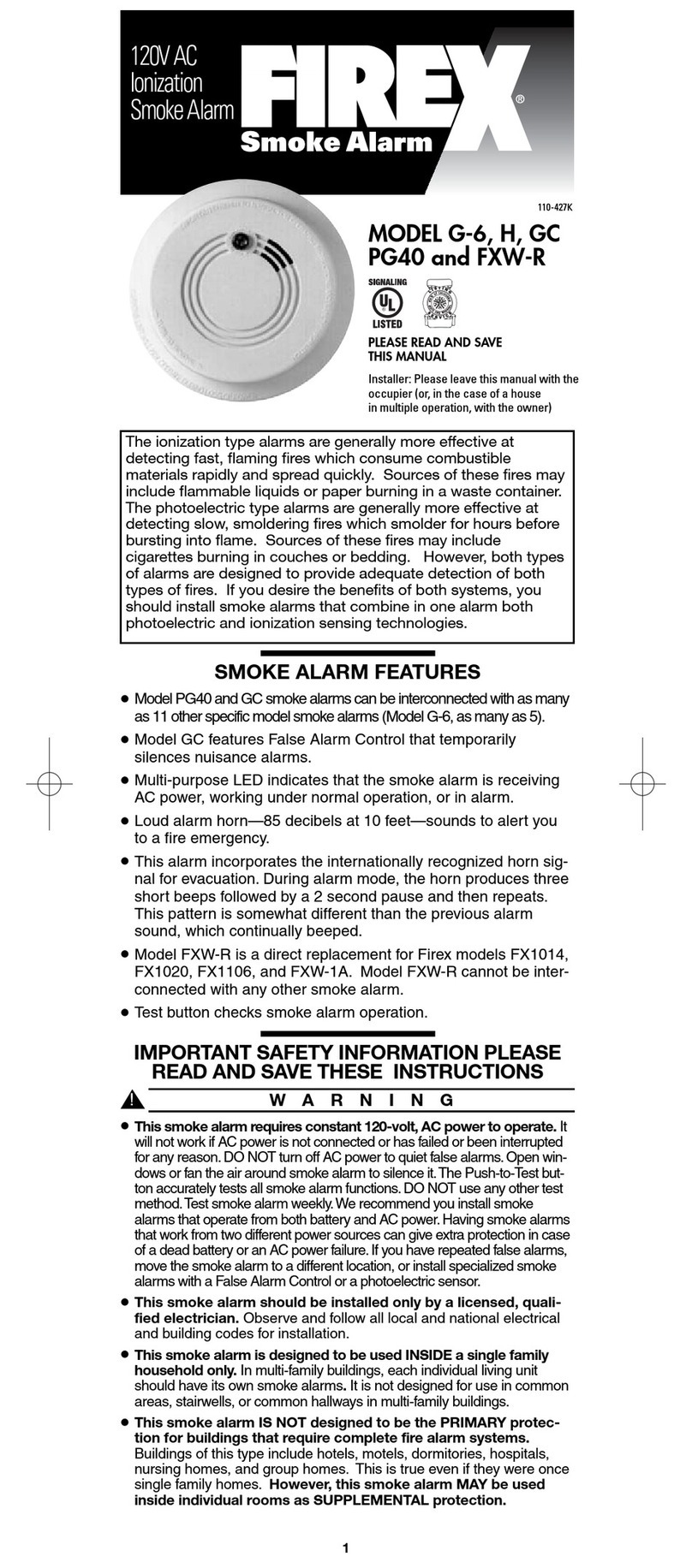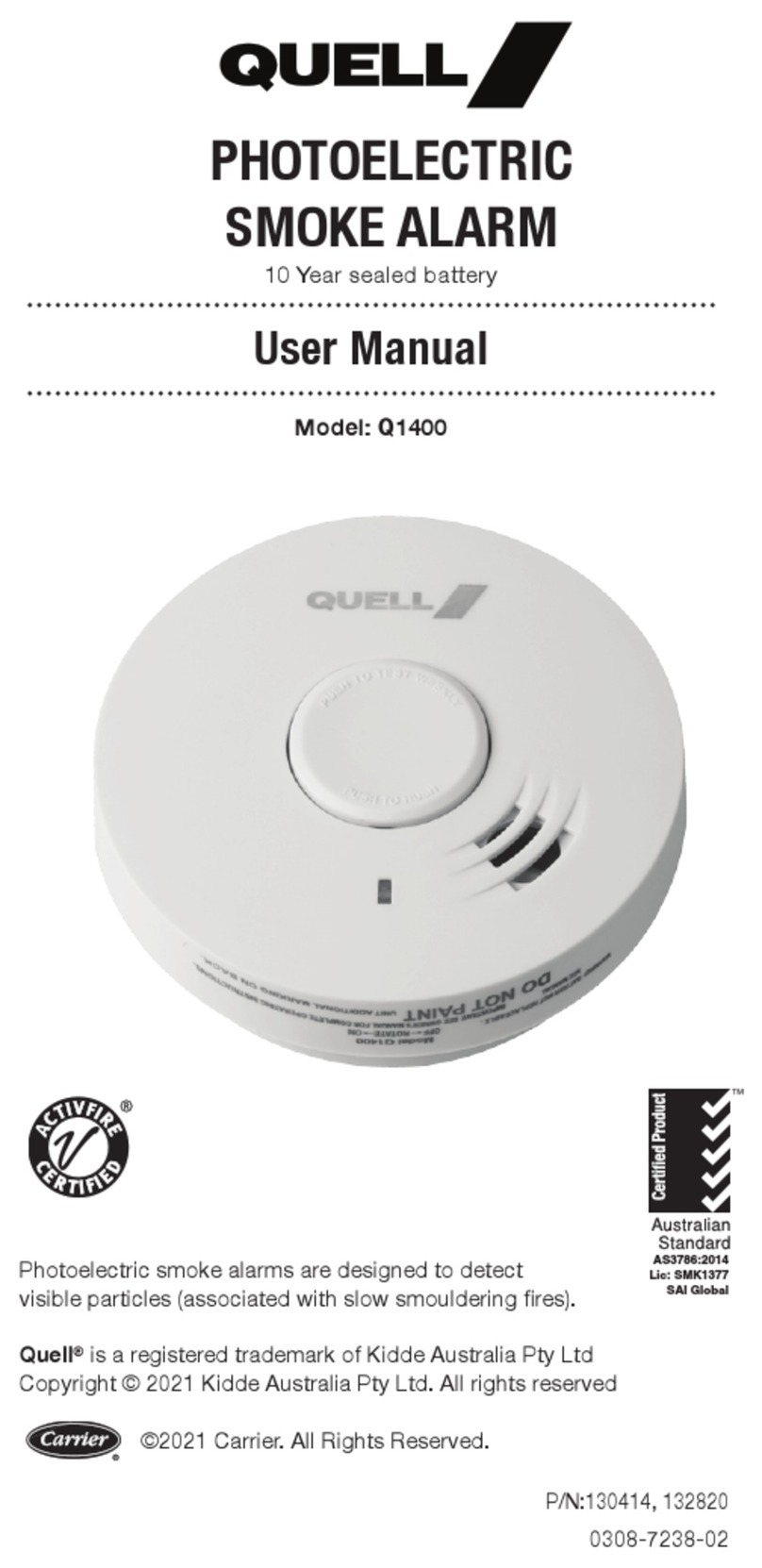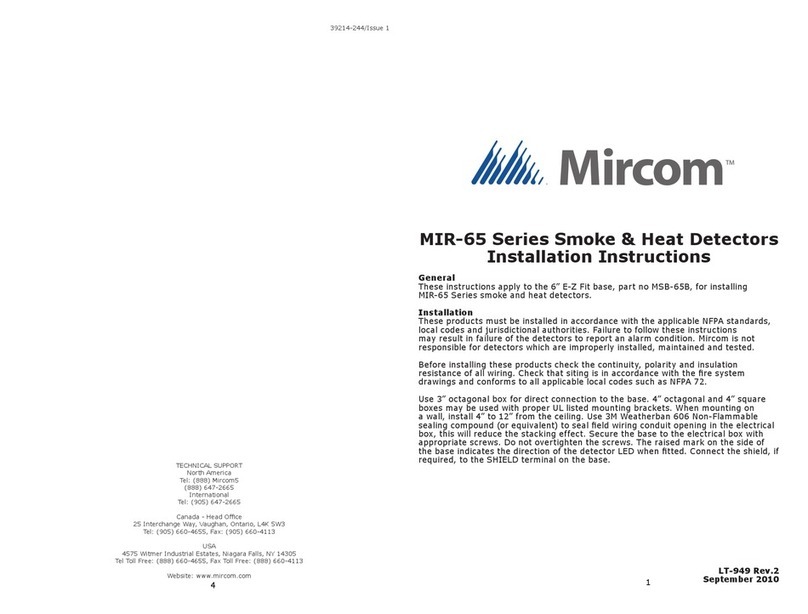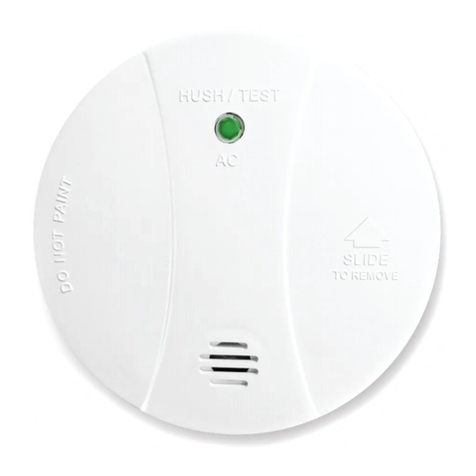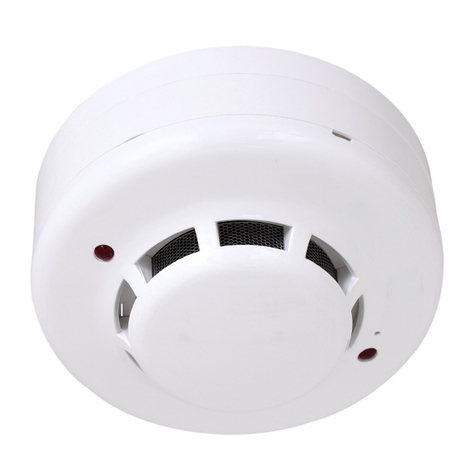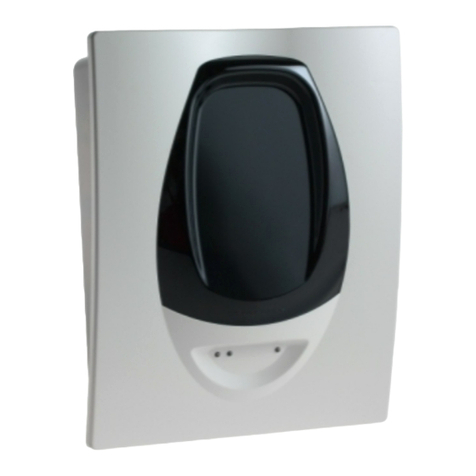Challenger SMART FORCE ASFSM User manual

Challenger_ASFSM_Instructions_Rev01
ASFSM
Wireless Smoke Detector
Installation and Operating Instructions
INTRODUCTION & OVERVIEW
This battery operated photoelectric Wireless Smoke Detector is designed to sense
smoke that comes into the detector chamber. It does not sense gas, heat, or flame.
It consists of a Smoke Detector and a RF module, which is designed to be worked
with a series of ASFK1 Smart Force Hub, operating at 868MHz only. The working
principle is when the smoke detector detects a certain density of smoke, the internal
sounder of smoke detector will sound and in the meantime, the RF module will emit
the signals to the control panel you have connected for further execution. It can
provide early warning for you and your family to escape before a fire spreads.
Please note that this detector is not interlinkable.
By pressing the Learning (Binding) key on the detector, it will emit the ID code to the
ASFK1 Smart Force Gateway Hub. As an indication of normal operation, the LED
on the detector will be flash once every 30 seconds. When battery level drops, the
detector will beep once every 30 seconds and emit radio signals to the control panel.
When this occurs, the battery should be replaced immediately.
PRODUCT LAYOUT
Horn Battery Cover
Test Button Tamper switch
LED Connector
Connector’s hole Learning (Binding) key
Cover Latch ○
10
Mounting bracket
⑪
Skirt Panel
CHOOSING MOUNTING LOCATION FOR THE SMOKE
DETECTOR
Compliance with the building Control or local authorities may need to be sought
prior to installing to ensure the smoke detector is suitable for the property type.
Optical Smoke Alarms are best at detecting smoldering fires such as those started
in electrical equipment, clothing and soft furnishings such as seating, bedding,
curtains and carpets. They are, therefore, ideally suited for living rooms, bedrooms
and escape routes in domestic accommodation. The detector is designed for use in
a single residential property only, and not dwellings of Housing Multiple Occupancy.
Smoke detectors, placed in common areas outside of the individual living unit, such
as on porches or in hallways, may not provide early warning to residents. In
multi-family buildings, each family living unit should set up its own detectors.
The detector is not meant to be used in non-residential buildings. Warehouses,
industrial or commercial buildings, and special purpose non-residential buildings
require special fire detection and alarm systems. This detector is not a suitable
substitute for complete fire detection systems for places where many people live or
work, such as hotels or motels. The same is true of dormitories, hospitals, nursing
homes or group homes of any kind, even if they were once single family homes.
For complete coverage in residential units, it should be installed in all rooms, halls,
storage areas, basements and attics in each family living unit. Minimum coverage
is one detector on each floor and one in each sleeping area.
Useful tips:
1. Install a detector in the hallway outside every separate bedroom area as shown
in Figure 1. Two detectors are required in homes with two bedroom areas as
shown in Figure 2.
Figure 1: locations for placing
smoke detectors for
single residence with
only one sleeping area
4
5
6
⑪

Challenger_ASFSM_Instructions_Rev01
Figure 2: locations for placing smoke
detectors for single-floor
residence with more than
one sleeping area
Figure 3: location for placing smoke
detectors for a multi-floor
residence
2. Install a detector on every floor of a multi-floor home or apartment as shown in
Figure 3.
3. Install a minimum of two detectors in any household.
4. Install a Detector inside every bedroom.
5. Install smoke detectors at both ends of a bedroom hallway if the hallway is more
than 40 feet (12 meters) long.
6. Install a detector inside every room where one sleeps with the door partly or
completely closed, since smoke could be blocked by the closed door and a
hallway alarm may not wake up the sleeper if the door is closed.
7. Install detectors as close to the center of the ceiling as possible. If this is not
practical, put the detector on the ceiling, no closer than 4 inches (10 cm) from
any wall or corner as shown in Figure 4.
Figure 4: recommended best and
acceptable locations to
mount smoke detectors
Figure 5: recommended location to
mount smoke detectors in
rooms with sloped, gabled
or peaked ceiling
8. If ceiling mounting is not possible, put wall-mounted detectors between 4 and 6
inches (10~15 cm) from the ceiling, see Figure 4.
9. If some of your rooms have sloped, peaked, or gabled ceilings, try to mount
detectors 3 feet (0.9 meter) measured horizontally from the highest point of the
ceiling as shown in Figure 5.
LOCATIONS NOT TO INSTALL THE SMOKE DETECTORS
Nuisance alarms take place when smoke detectors are installed where they will not
work properly. To avoid nuisance alarms, do not install smoke detectors in the
following situations:
1. Combustion particles are the by-products of something that is burning. Thus,
in or near areas where combustion particles are present you do not install the
smoke detectors to avoid nuisance alarms, such as kitchens with few windows
or poor ventilation, garages where there may be vehicle exhaust, near furnaces,
hot water heaters, and space heaters.
2. Do not install smoke detectors less than 20 feet (6 meters) away from places
where combustion particles are normally present, like kitchens. If a 20-foot
distance is not possible, e.g. in a mobile home, try to install the detector as far
away from the combustion particles as possible, preferably on the wall. To
prevent nuisance alarms, provide good ventilation in such places.
IMPORTANT: For any reason, do not disable the detector to avoid nuisance
alarms.
3. When air streams passing by kitchens, the way how a detector can sense
combustion particles in normal air-flow paths is graphically shown in Figure 6,
which indicates the correct and incorrect smoke detector locations concerning
this problem.
Figure 6: recommended smoke detector locations
to avoid air streams with combustion
particles

Challenger_ASFSM_Instructions_Rev01
4. In damp or very humid areas, or near bathrooms with showers. Moisture in
humid air can enter the sensing chamber, then turns into droplets upon cooling,
which can cause nuisance alarms. Install detectors at least 10 feet (3 meters)
away from bathrooms.
5. In very cold or very hot areas, including unheated buildings or outdoor rooms.
If the temperature goes above or below the operating range of smoke detector,
it will not work properly. The temperature range for your smoke detector is 4°C
to 38°C (40°F to 100°F).
6. In very dusty or dirty areas, dirt and dust can build up on the detector’s sensing
chamber, to make it overly sensitive. Additionally, dust or dirt can block
openings to the sensing chamber and keep the detector from sensing smoke.
7. Near fresh air vents or very drafty areas like air conditioners, heaters or fans,
fresh air vents and drafts can drive smoke away from smoke detectors.
8. Dead air spaces are often at the top of a peaked roof, or in the corners between
ceilings and walls. Dead air may prevent smoke from reaching a detector.
See Figure 4 and 5 for recommended mounting locations.
9. In insect-infested areas. If insects enter a detector’s sensing chamber, they
may cause a nuisance alarm. Where bugs are a problem, get rid of them before
putting up a detector.
10. Near fluorescent lights, electrical “noise” from fluorescent lights may cause
nuisance alarms. Install smoke detectors at least 5 feet (1.5 meters) from
such lights.
WARNING: Never remove batteries to stop a nuisance alarm. Cooking smoke or a
dusty furnace, sometimes called “nuisance alarms” can cause the alarm to sound.
If this happens, open a window or fan the air around the detector to get rid of the
smoke or dust. The alarm will turn itself off when the smoke is gone. If nuisance
alarms persist, attempt to clean the detector as described in this Manual.
WARNING: Do not stand close to the detector when the alarm is sounding. The
alarm is loud in order to wake you in an emergency. Too much exposure to the
horn at close range may be harmful to your hearing.
INSTALLING THE SMOKE DETECTOR
1. At the place where you are going to install the detector, draw a horizontal line six
inches long.
2. Remove the mounting bracket from the detector by rotating it counterclockwise.
(Figure 7)
Figure 7
3. Place the bracket so that the two longest hole slots are aligned on the line. In
each of keyhole slots, draw a mark to locate a mounting plug and screw.
4. Remove the bracket.
5. Using a 3/16-inch (5mm) drill bit, drills two holes at the marks and insert plastic
wall plugs. Put the detector away from getting plaster dust on it when you drill
holes for mounting.
6. Using the two screws and plastic wall plugs (all supplied), attach the bracket to the
wall.
7. Line up the slot of the bracket and the detector. Push the detector onto the skirt
panel and then the mounting bracket and turn it clockwise to fix it into place.
(Figure 8) Pull outward on the detector to make sure it is securely attached to the
mounting bracket.
Figure 8
8. The steps to open the battery cover and to install the battery are listed as follows:
a. To power the detector requires a 9V alkaline battery. (The fixing pack is
included a 9V battery which is treated as a giveaway.)
b. Open the battery cover and connect the battery with +ve and –ve in the
correct position. Push battery firmly in until it snaps and cannot be shaken
loose.
Note: It comes with cover latches that will
prevent the battery cover from closing if battery
is not installed. (Figure 9)This tells you that the
smoke detector will not work until a new battery
is properly installed.
Figure 9
c. Place the connector to the connector hole. Ensure
that the direction of connector is inserted correctly
according to the sticker affixed on the detector.
(Figure 10)
Figure 10

Challenger_ASFSM_Instructions_Rev01
9. As soon as the battery is installed, the Status LED will flash at 2-second intervals.
It implies that the detector does not memorize any ID code and cannot work with
Gateway Hub at this stage. The detector will need to be learnt the Gateway Hub
prior to installing.
OPERATING THE WIRELESS SMOKE DETECTOR
In order to prevent any unauthorized attempt to operate or disarm your system, you
mustconfigure your system to accept radio signals onlyfrom your own system devices.
This is done by learning the ID code with Gateway Hub. The learning procedure
reads as follows:
1. The easiest wayto learn the device is either via through the Smart Force Web Site
or Smart ForceApp once you have completed the System Registration.
2. Press and hold the learning key (Binding) on the detector for about 3 seconds and
release, the Status LED adjacent to the tamper switch starts flashing. Learning
timeout is 30 seconds.
3. If successful, the Status LED will be on shortly before exit the learning mode. If a
new code needs to be learned, start from step 2.
4. If failed, the Status LED will flash three times rapidlybefore exit the learningmode.
To clear the ID code, follow the steps below:
1. Press and hold the learning keyon the detector for about 3 seconds and release.
2. Press the learning key again for more than 6 seconds. All of the codes learned will
be cleared and the Status LED will be on rapidly before exit.
When smoke detector is removed on purpose from the wall or ceiling, the Status LED
will be on rapidly and radio signals will be transmitted to the control panel
simultaneously.
The detector sounds as long as the test button is pressed for 3 seconds or there is
smoke in the detector. When the detector goes off, always check carefully to see that
there is no fire and never remove the battery from the detector except when changing
it!
Always test the detector once a month or immediately after returning from holiday or
after a longer period of absence. Under the test button, there is a red control LED
which flashes once every 30 seconds. It indicates the detector under normal
operation. When smoke detector senses smoke and simultaneously sounds an
audible alarm, the red LED will flash very frequently, once 0.67 seconds. If the
detector does not sound when testing, the batterymust be replaced.
WARNING: Never use an open flame to test your detector. You may set fire to
damage the detector, as well as your home.
WARNING: When you are not testing the unit and the alarm horn sounds a loud
continuous sound, this means the detector has sensed smoke or combustion
particles in the air. Be sure that the alarm horn is a warning of a possible serious
situation, which requires your immediate attention.
MAINTENANCE
The smoke detector is powered by a 9V alkaline battery which under normal
conditions will have typical life in excess of 1 year. Replace the battery once a year.
When changing the battery, clean and vacuum the dust off the detector’s sensing
chamber carefully using a soft brush.
If the voltage level of smoke detector falls below 7.5 Volts, it will emit beep sound
once every 30 seconds and in the meantime the RF module will transmit radio
signals to the control panel. When this happens, replace battery at once.
TROUBLESHOOTING
Symptom
Recommendation
LED not illuminating, the control
panel not working
1.
Replace battery
2. Have control panel learned the code
again
Not working when pressing the
test button
1.
Reverse battery polarity or poor
battery connections
2. Battery power has been depleted
3. Keep pressing the test button about
3 seconds
The control panel not responding
when pressing the tamper switch
1.
Re
-
start learning the code
2. Check if the battery power has been
depleted
SPECIFICATIONS
Frequency Range 868.30MHz
Battery Type 9V /540mAalkaline battery x 1
Range 100 meters in open space
Due to our policy of continuous improvement we reserve the right to change specification
without prior notice.
Errors and omissions excepted. These instructions have been carefully checked prior to
publication. However, no responsibility can be accepted by Challenger for any
misinterpretation of these instructions.
Challenger Security Products
10 Sandersons Way, Blackpool, FY4 4NB
Tel: 01253 791888, Fax: 01253 791887
Email: enquiries.challenger@adivision.co.uk
Web: www.challenger.co.uk
Popular Smoke Alarm manuals by other brands

Honeywell
Honeywell Fire-Lite Alarms BEAM355A Installation and maintenance instructions
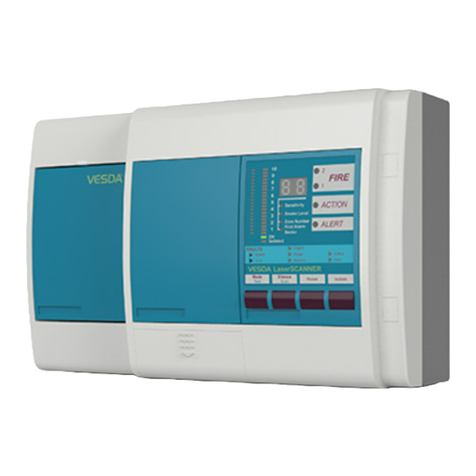
VESDA
VESDA LaserSCANNER VLS-200 installation manual
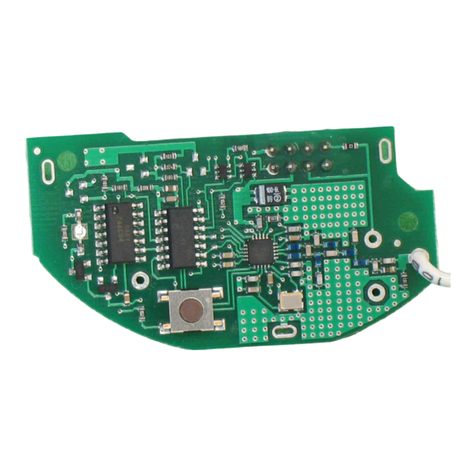
Ei Electronics
Ei Electronics EiA207 Series instructions
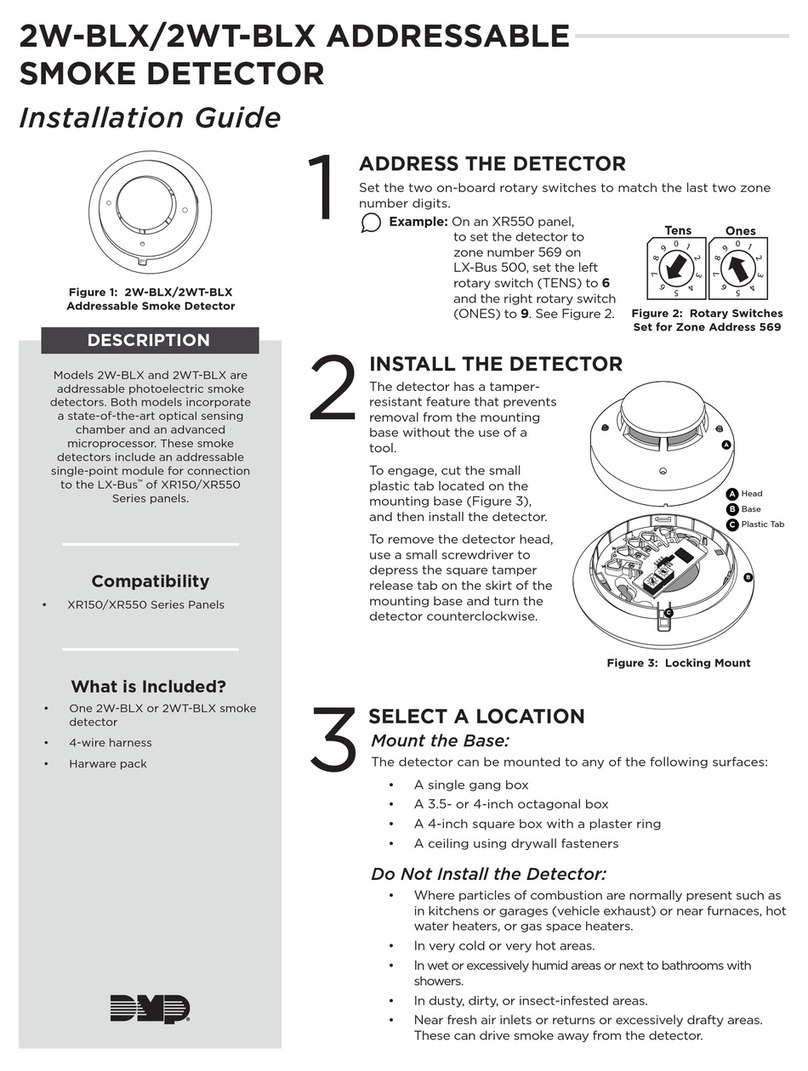
DMP Electronics
DMP Electronics 2W-BLX installation guide
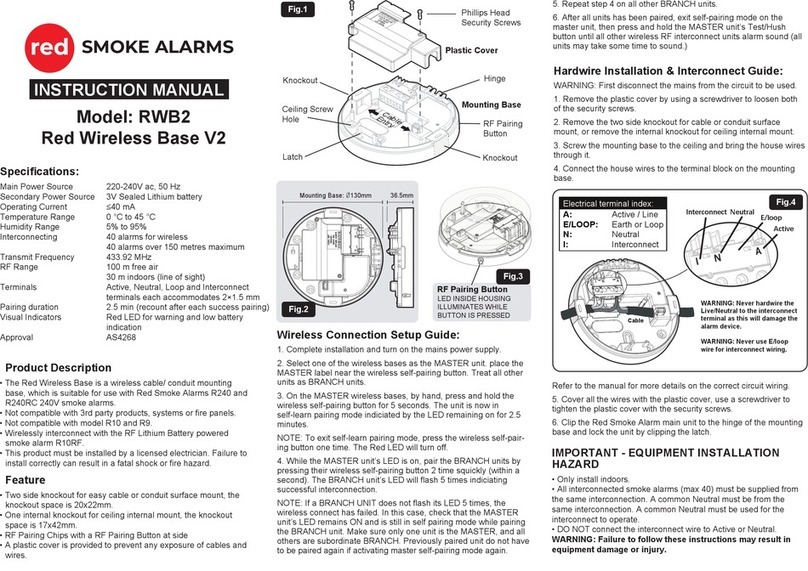
RED
RED RWB2 instruction manual
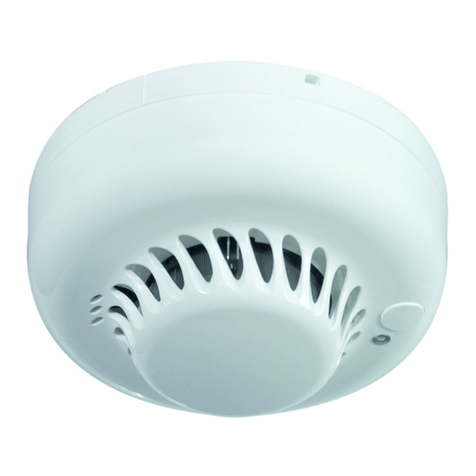
Abus
Abus FURM30000 user manual
